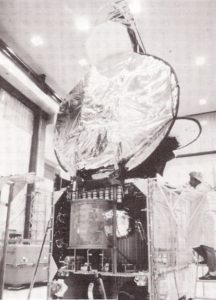Battery Work with COMSAT
Johnson Controls and COMSAT team up on advanced battery system
May 9, 1984 (PD: 201711)

A COMSAT technician works on a satellite that incorporates a hydrogen-nickel oxide battery system for energy storage
The May 9, 1984 edition of the Johnson Controls Briefing newsletter announced that the company and the Communications Satellite Corporation (COMSAT) had signed a technology licensing agreement and formed a joint venture research program to develop an advanced battery system for aerospace and other applications.
Under the joint venture program, the two companies were to work on improving COMSAT’s hydrogen-nickel oxide battery technology that was used in commercial satellite systems. While COMSAT’s hydrogen-nickel oxide batteries were already highly reliable and long-lived, it was anticipated that Johnson Controls’ expertise in electrochemistry and application engineering would maximize the technology’s performance and significantly lower its cost. The licensing agreement provided Johnson Controls with the rights to manufacture and market any hydrogen-nickel oxide battery technology the two companies created.
COMSAT pioneered the development of hydrogen-nickel oxide technology and had been conducting research on the battery system for twelve years at their laboratories in Clarksburg, Maryland. Johnson Controls had been involved in the development and evaluation of the hydrogen-nickel oxide battery for two years while also conducting research into a number of other advanced battery technology systems such as zinc-bromine and zinc-nickel oxide. At the time of the joint venture and licensing agreement, both companies were already involved in a U. S. Department of Energy advanced battery project at the Sandia National Laboratory.

